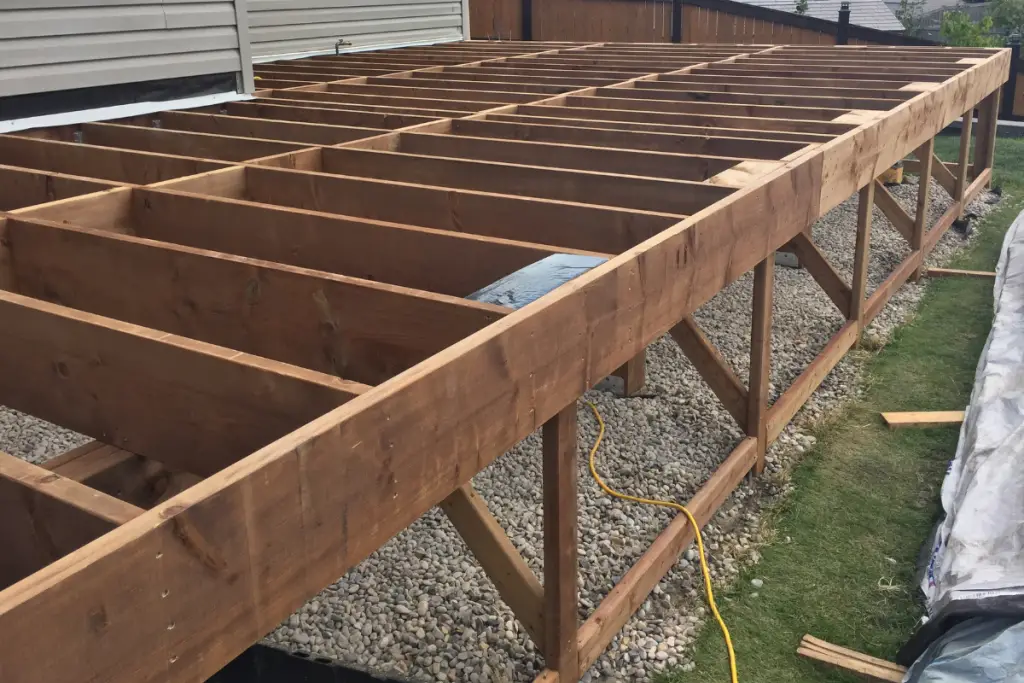Have you watched the neighbour’s deck being built and wondered why the carpenter installed blocking between the deck joists?
The purpose of blocking between deck joists is to rigidity for the joists so that they do not buckle, sway, or wobble under from movement or weight on the deck. Joists blocking between joists can be installed in a straight line or a “step” fashion.
After walking on many decks and building many more, I can assure you deck blocking makes a difference and will improve your deck. It is one of those things that you don’t see from your deck but makes a big difference in your deck enjoyment.
Let me explain why you need them, where to place them, what sizes you need, how you get them, and all the regulations concerning them.
What Is The Purpose Of Blocking Between Deck Joists?
The primary purpose of blocking between deck joists is to create stability and support for each joist so that they remain sturdy and rigid under the weight of the floor. In simpler terms, they prevent the joists from wobbling to and fro due to pressure from the deck flooring or movement from individuals on the deck.
“Joists blocking make your joists work together as a team. “
Even though most joists are pressure-treated 2X6, 2X8, or 2X10s (this will depend on the size of your deck), they are not impervious to forces like gravity or weight. Moreover, even when installed correctly, using galvanized hangers, nailed to the beam and rim joists, they are still prone to sway and wobble. This is where joist blocking comes in.
What Is Joist Blocking?
A joist block is a piece of wood that sits perpendicular to the joists on your deck. They are fastened securely to the joists in either a “step/criss-cross” fashion or in a straight line. I prefer criss-cross as nailing is easier, but a straight line may look better from underneath the deck with a higher deck.

What Size Should Joist Blocking Be?
Joist blocking is often the same size as the joists, but this is not required.
Installing joists block the same size as the joists allows you to use up scraps from the joists and cut up and install warped or twisted joists. Which is the biggest reason why deck blocking often matches the joists, but the building code only requires blocking to be 60% of the height of the joists.
At 60% you can install 2×6 blocking between 2×10 joists. This may be required if you have a dry space under your deck and need clearance for the trough.
Smaller blocking can also be helpful when installing composite decking. The smaller dimension can be installed lower than the top of the joists preventing waves in your decking.
But I generally use the same size blocking as the joists for two reasons.
- Save money by using scraps
- Increase strength
Saving money and reducing waste during construction are music to my ears. Using warped joists and offcuts does both.
Plus, the larger blocks will lock together a bigger portion of the joists reducing the potential for the top or bottom of the joists from twisting.
“Code is only the minimum”.
With deck blocking building better, is better than building to the minimum.
Where Should Joist Blocking Be Installed?
Joist blocking needs to be placed every 4 to 6 feet and on every beam, especially before a cantilever (overhang).
With a 12′ joist or less, blocking in the centre is ideal for maximum effect. With longer joists, a row of blocking at a third of the length of the joist is ideal.
However, you will not need to place joist blocking in two areas of your deck. The first is by the house because the deck ledger board essentially holds the joists in place.
The other end at the rim board, deck blocking is also not required. Like the ledger, the rim is fastened to the joist, holding them in place.
The exception here is earthquake zones, where blocking is often required between the joists above the beam. Which is very close to the rim.
How to Install Deck Joist Blocking
Installing deck joists blocks is simple if you know how.
1. With a chalk line, snap a straight line at the desired locations for the blocking
2. Measure the distance between the deck joists. At the beam or rim joists.
3. Cut the blocking to that size from scrap boards.
*Deck Builder Tip*
“Cut joists blocking a 1/16 or 1/8 short.”
4. Apply end coat treatment to the ends of the blocking
5. Nail the blocking in place between the deck joists.
Either lined up with the chalk line or crisscrossing from one side of the line to the other. Use a speed square or framing square to plumb up the blocking.
Nails are stronger than and will hold the block into place better. Unless you use structural screws which are not brittle like regular deck screws. Which are good for decking, bad for the substructure.
Additional Benefits of Joists Deck Blocking
Joists correctly spaced will support your decking better, but it is possible for joists to curve and weave without blocking.
Which is an additional advantage of joist blocking. A straight line of decking fasteners and correct joists spacing under the decking for the entire length of the joists.
Conclusion
Joist blocking is a vital part of any decking construction, playing an essential role in stabilizing and supporting the joists that hold up the deck. Without them, the joists would be prone to wobbling, twisting and warping and would not be very secure.
